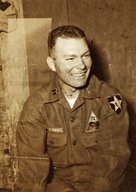
|

|
|
|
|
Charles was born in Trenton, Alabama, to Floyd Marshall Rich and mother, Mary Emma Hardes Rich, who left the family when he was an infant. His father, a farmer, moved the family to the Houston area and re-married. In all, Charles would have one brother and two half brothers. Charles worked on his father's farm, milking cows, plowing with mules, horses, and tractors, and raising cotton, corn, and garden products. For leisure he fished and hunted and played high school football. After graduating from high school in Sugar Land in May of 1939, Charles enlisted in the cavalry of the U.S. Army at age 17. At Fort Ringgold in Rio Grande City, Texas he was placed in F Troop of 1st Cavalry Division. From September to mid-December his unit participated in maneuvers to El Paso, traveling horseback for more than 500 miles. He also participated in the Louisiana Maneuvers in 1940. That December he was sent to Fort Riley, Kansas to train draftees. A sergeant by then, he entered Officer Candidate School in February of 1942. Meanwhile, cavalry units were switching from horses to tanks. As a second lieutenant, he reported to Camp Bowie in Texas and was placed in the 744th Tank Battalion, and trained in several types of tanks. He was transferred to Fort Hood near Killeen, Texas, as one of the first tank units based there. In January of 1944 Charles sailed for Great Britain with the 744th to train for D-Day. He was in charge of the assault gun platoon, consisting of three tanks mounted with 77-millimeter artillery guns. Charles went ashore at Omaha Beach on D-Day (he believes in the fourth wave) in the afternoon of June 6, 1944. "There's no way you can describe the destruction and the number of people dead," he recalls. In the drive east from the French coast his unit was tasked to "shoot wherever you had to shoot and keep moving," he recalls. No tanks were lost in his platoon. Late in the conflict he fell ill and was sent to a hospital in London. After the war ended he returned to Camp Bowie. In September of 1946 he was sent to Tokyo. There his unit helped operate the prison where seven Japanese war criminals on trial were incarcerated. Charles served as motor officer, working mostly with well-used equipment from World War II. "That was a job," he recalls. "People in Japan were glad the war was over and they were very nice people," he says of the civilians. He returned to America in August of 1949 and was stationed at Fort Leavenworth in Kansas where he was in charge of the extension course department for education by correspondence. In September of 1952 he was sent to Korea as commander of C Company 72nd Tank Battalion of 2nd Infantry Division, with 15 tanks. He was in the central part of South Korea in the Chorwon Valley. He fought in "a few skirmishes" but says the 38th parallel, by then, was "pretty well stabilized." Charles returned to the States in September of 1953, and was stationed at Fort Riley, Kansas with a tank battalion in the 10th Infantry Division. On October 22, 1955 he married Charmaine Weist. (They would have three children and five grandchildren.) He spent five years in Flint, Michigan as an advisor to army reserves personnel, then retired from service. Returning to Texas, he worked 13 years for a chemical company until he retired. He worked for Red Cross for ten years, in charge of the unit in Angleton. |


